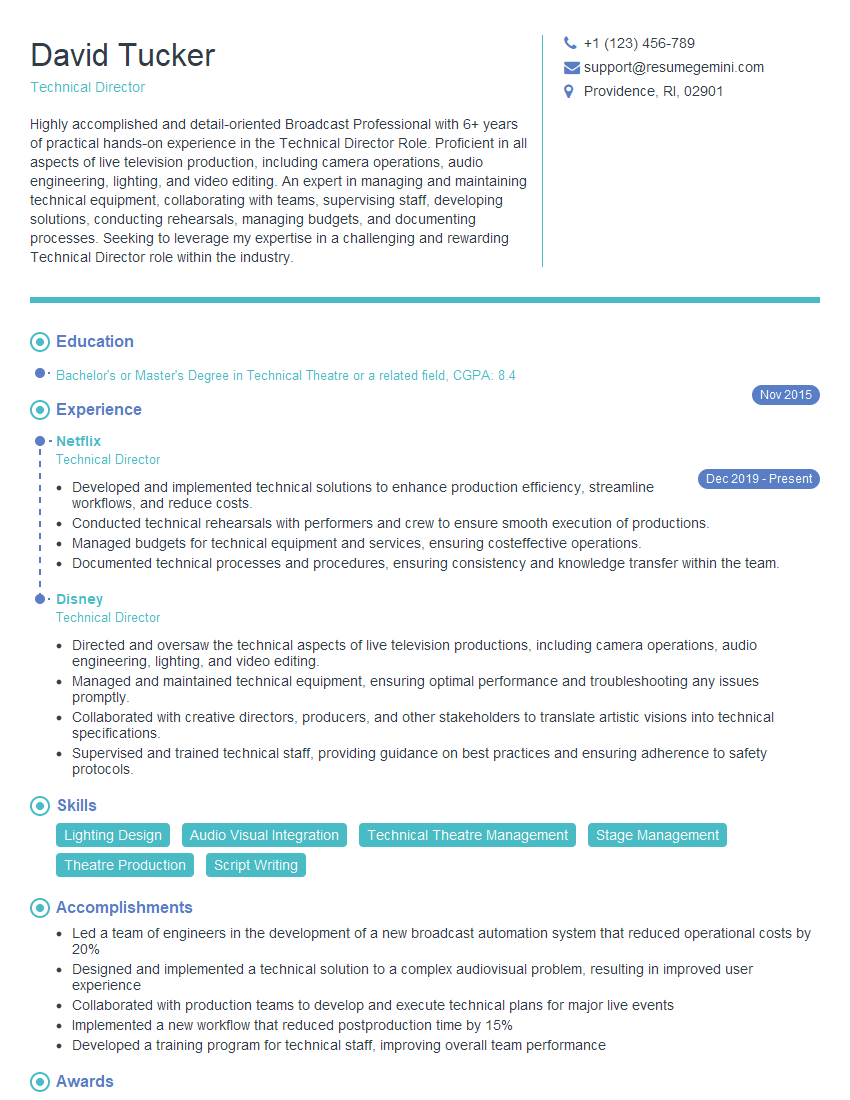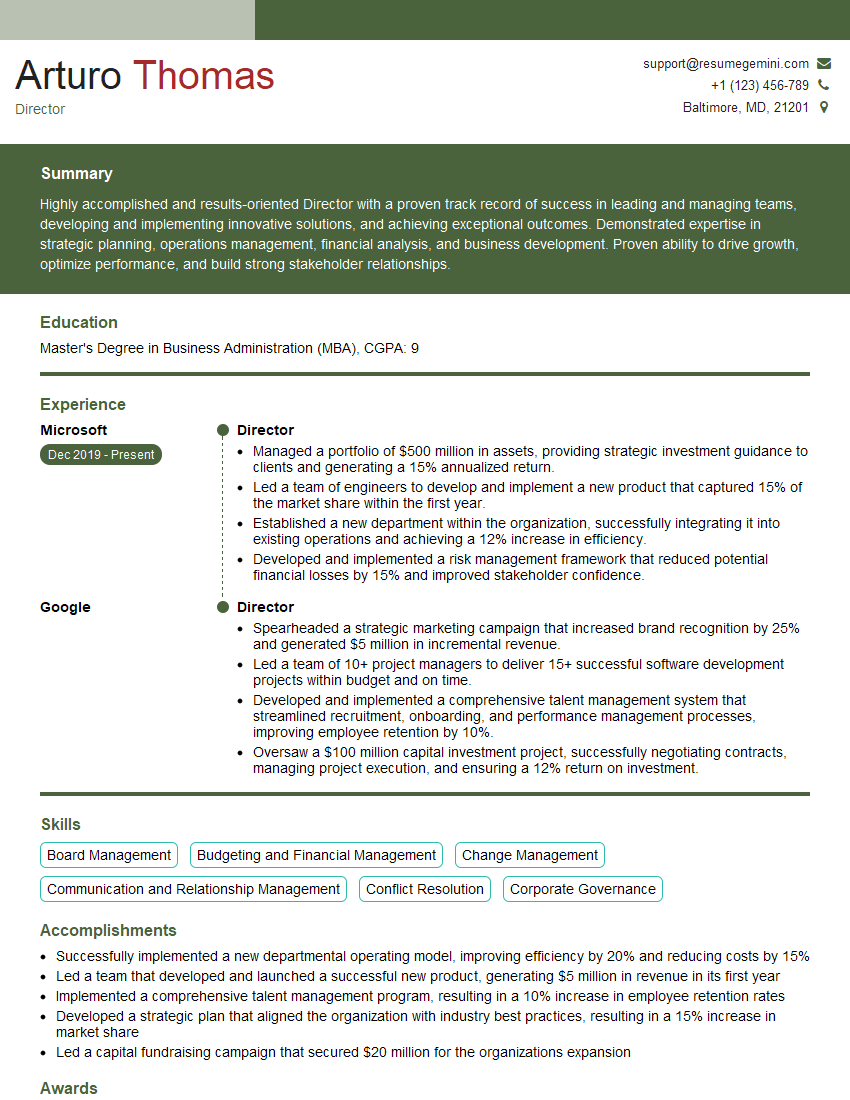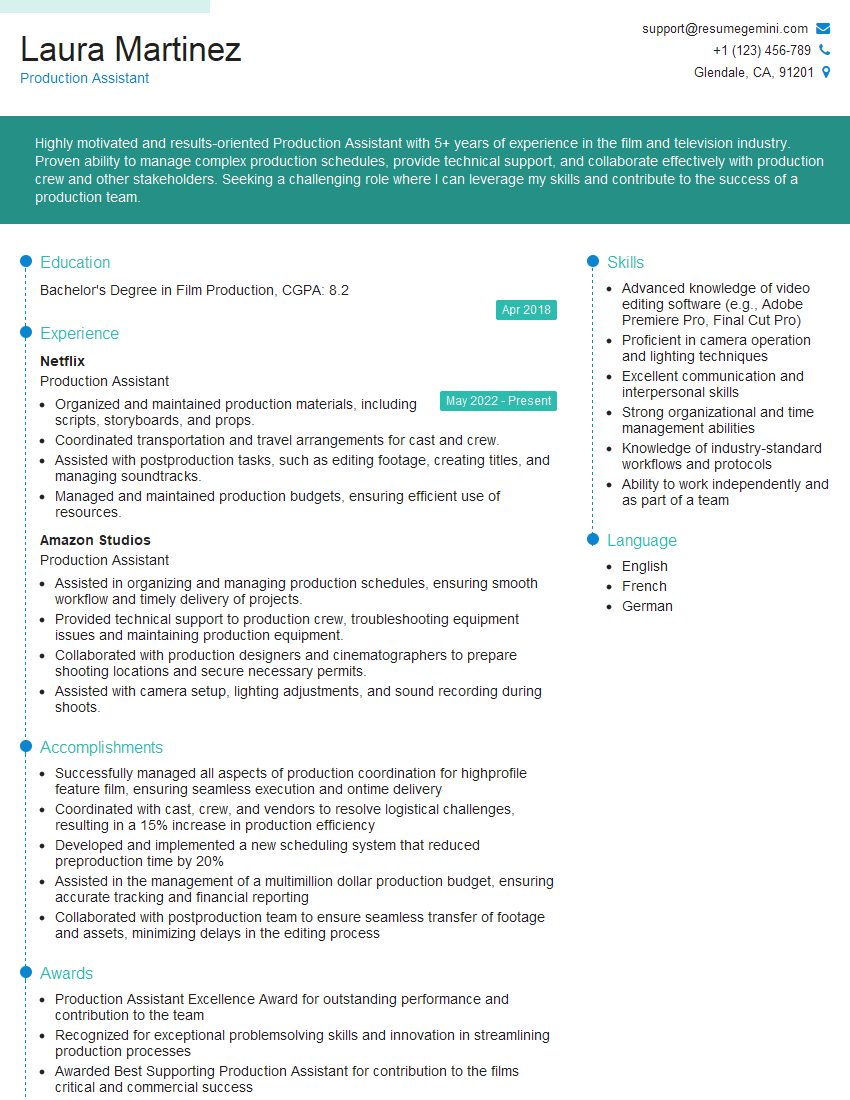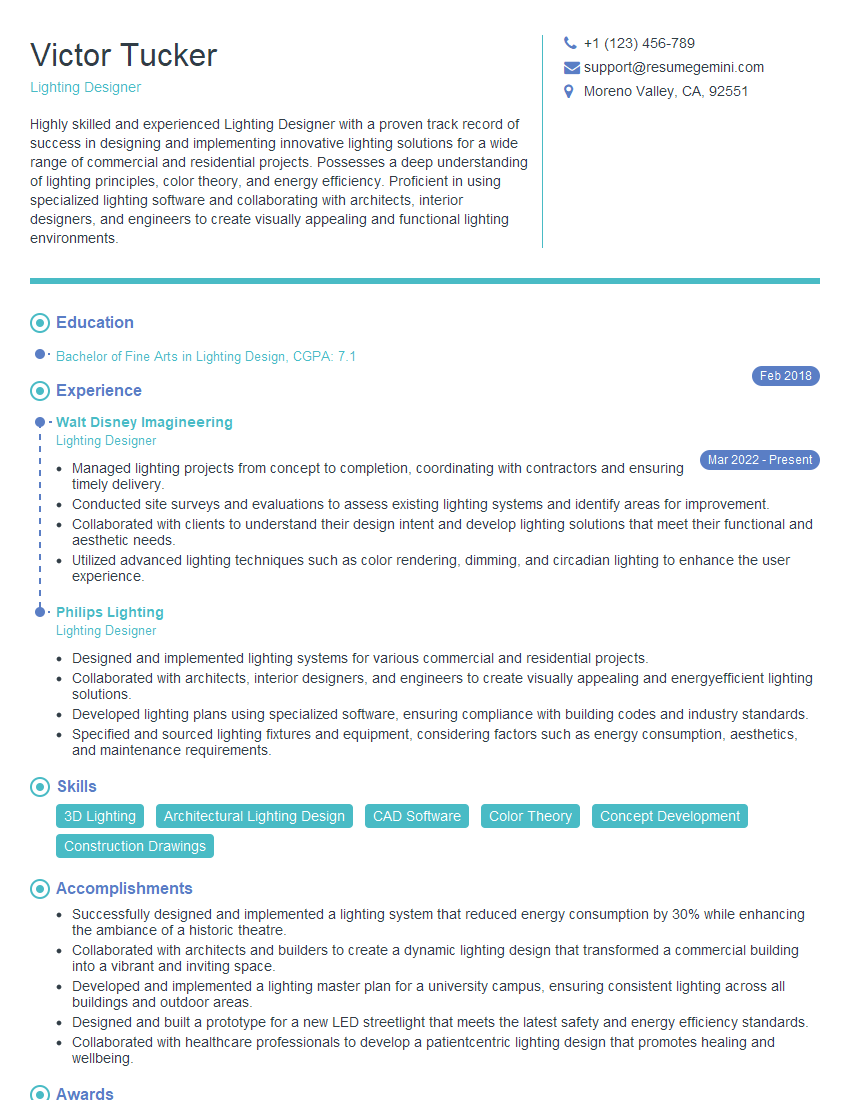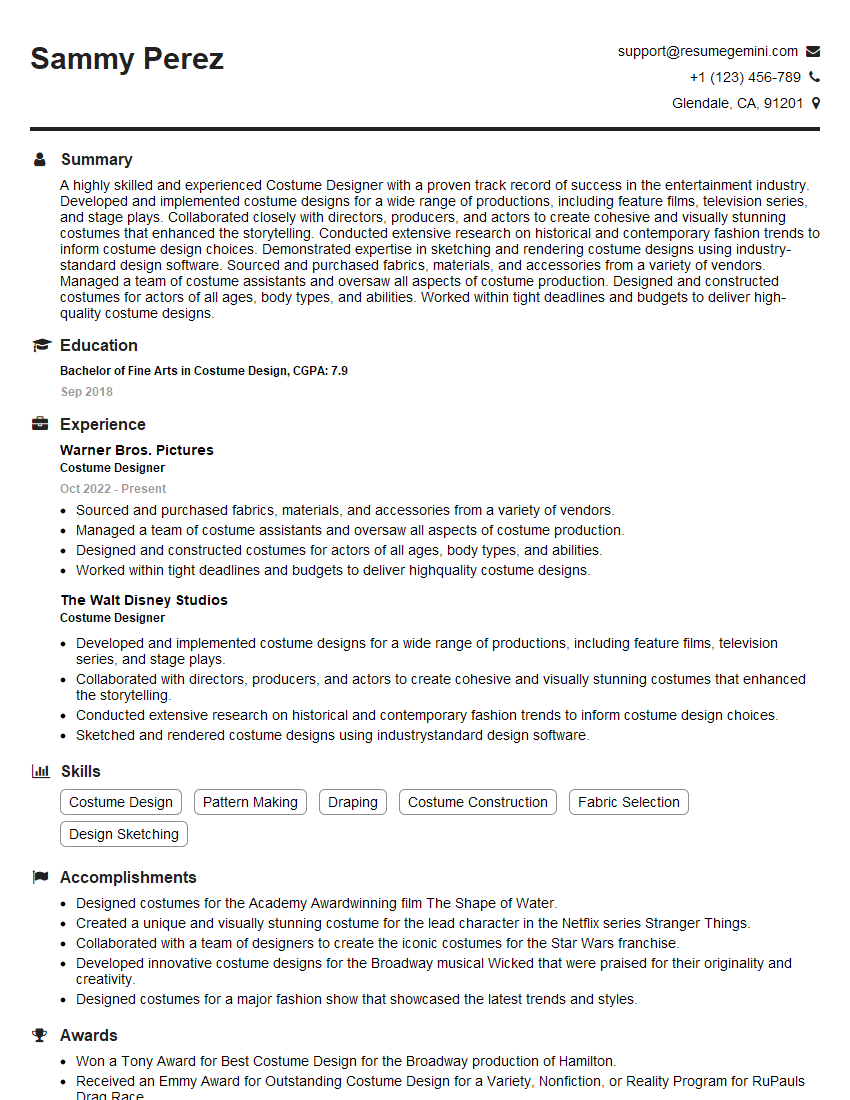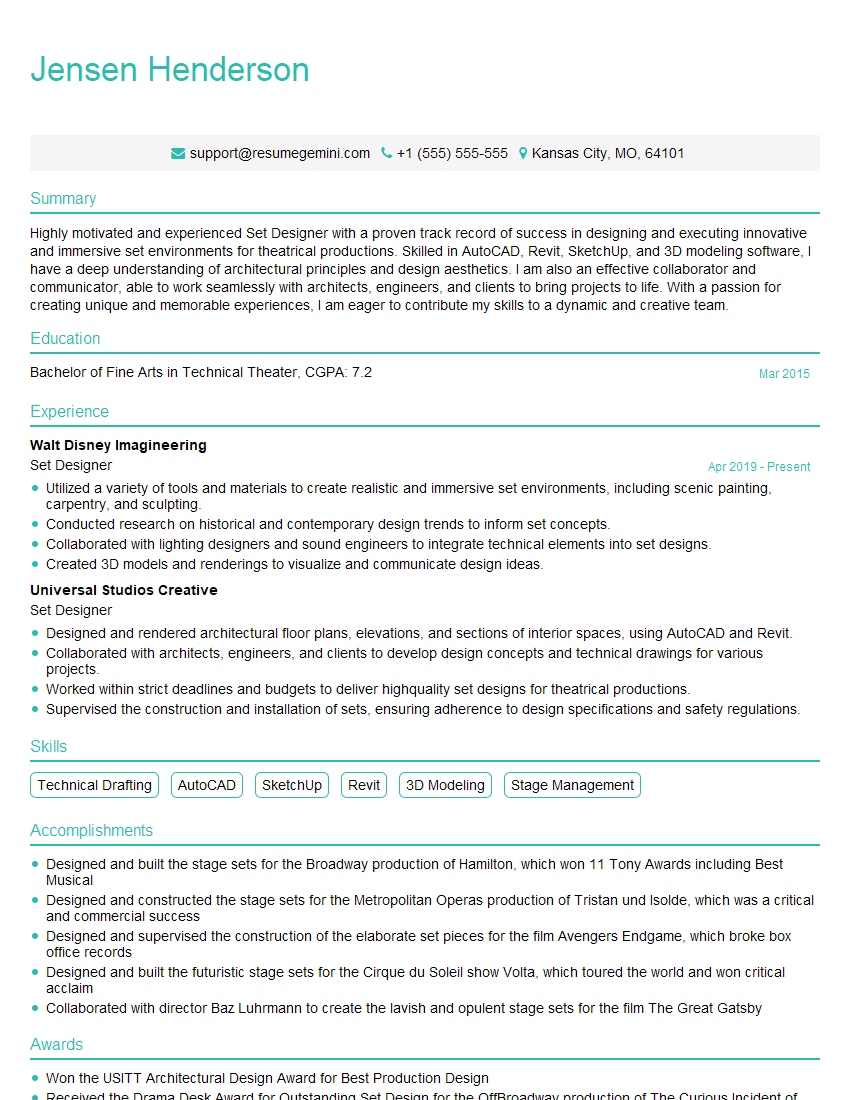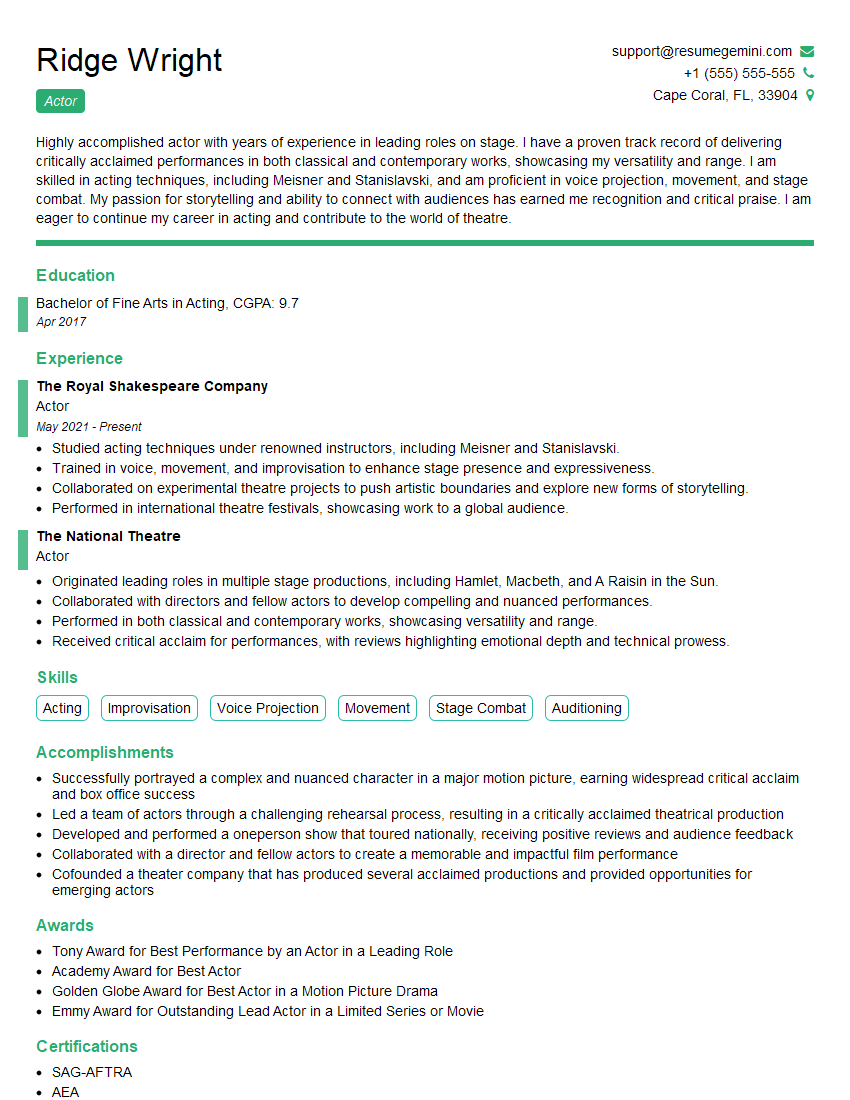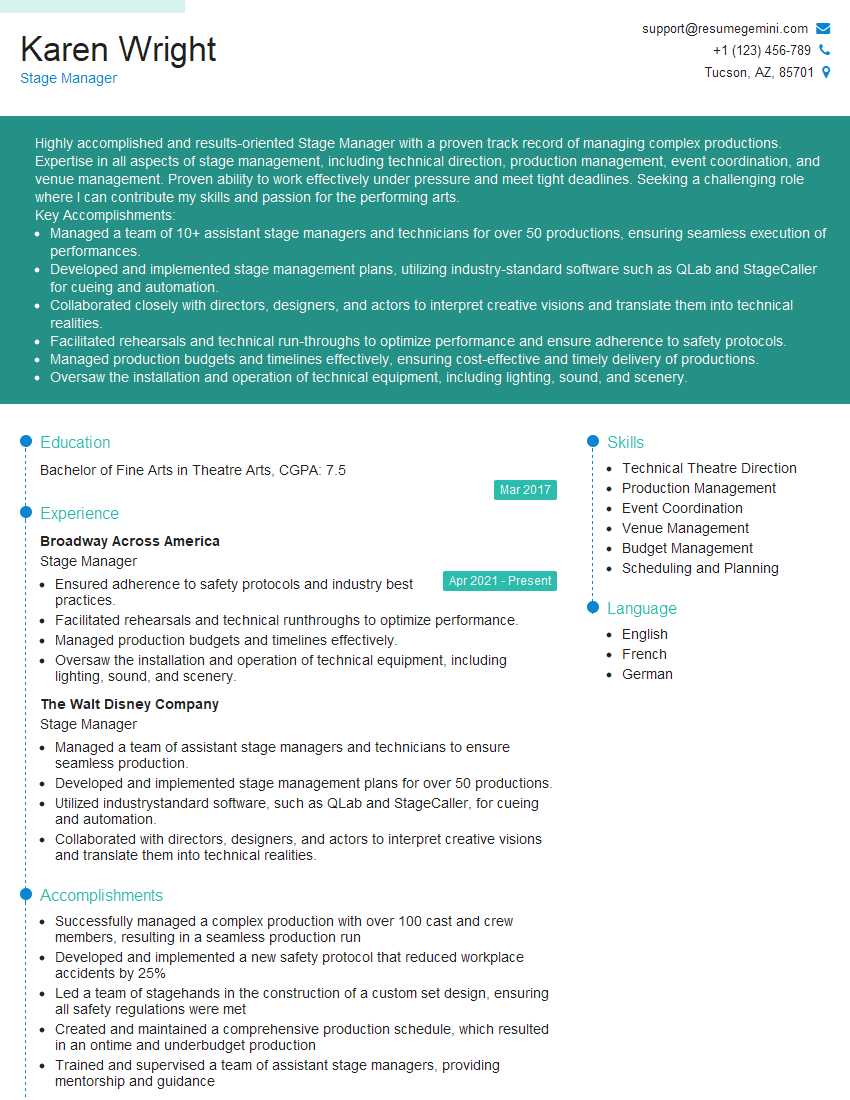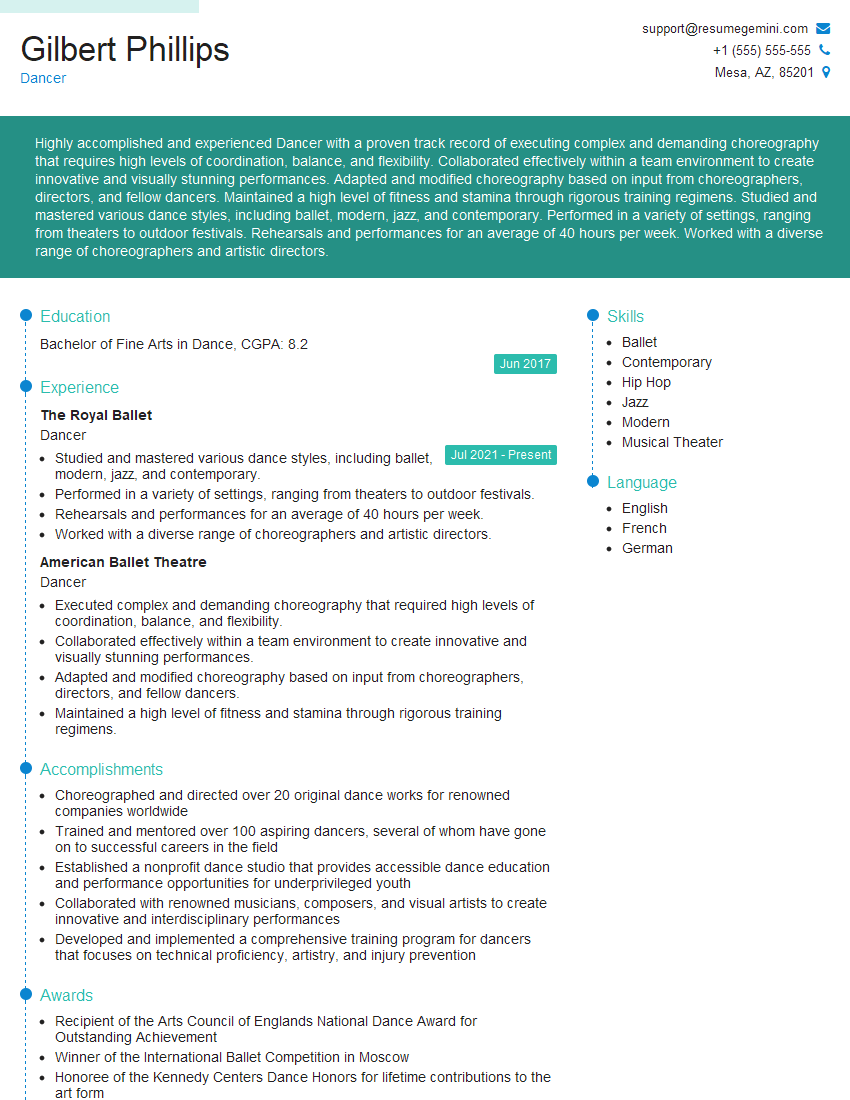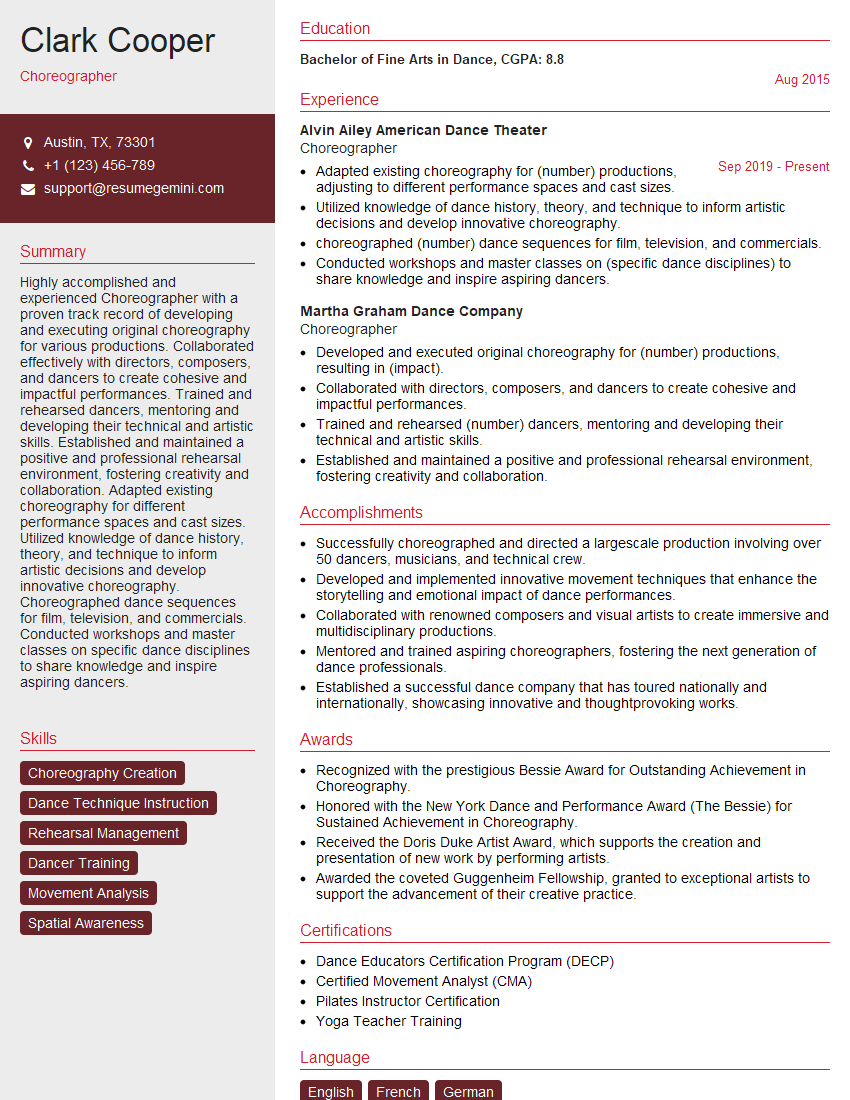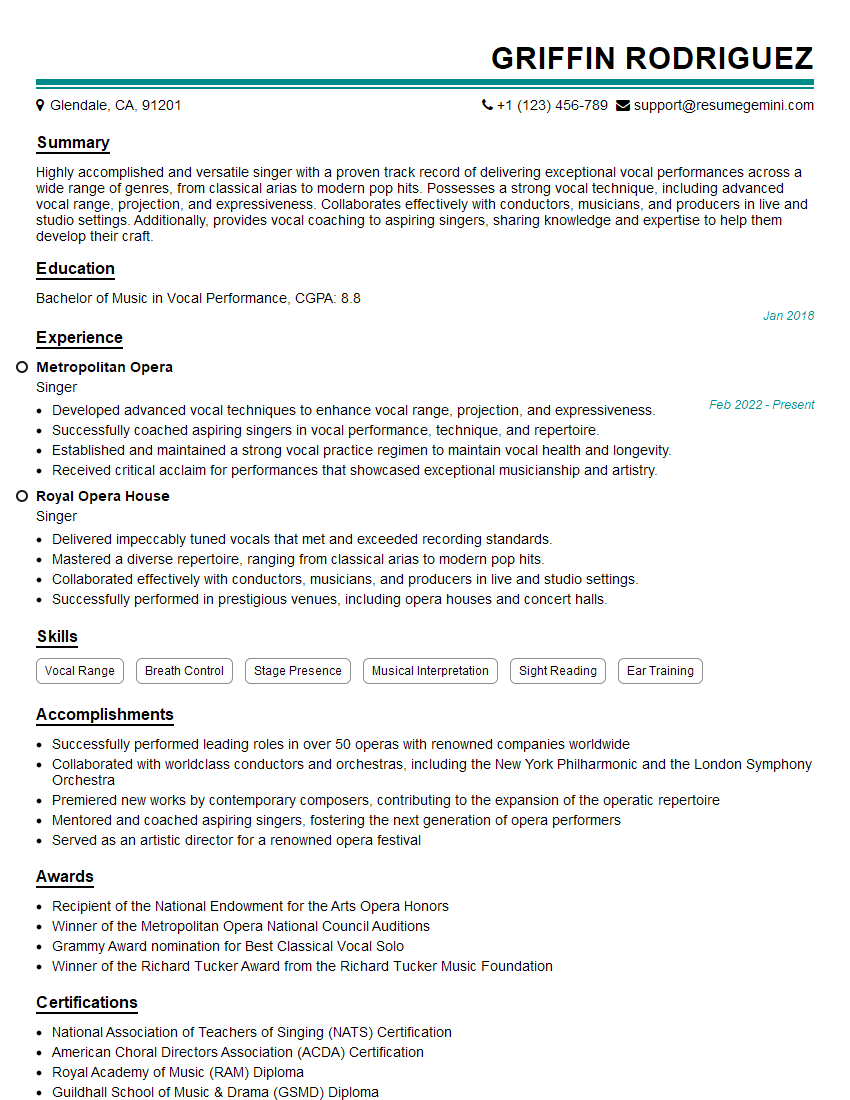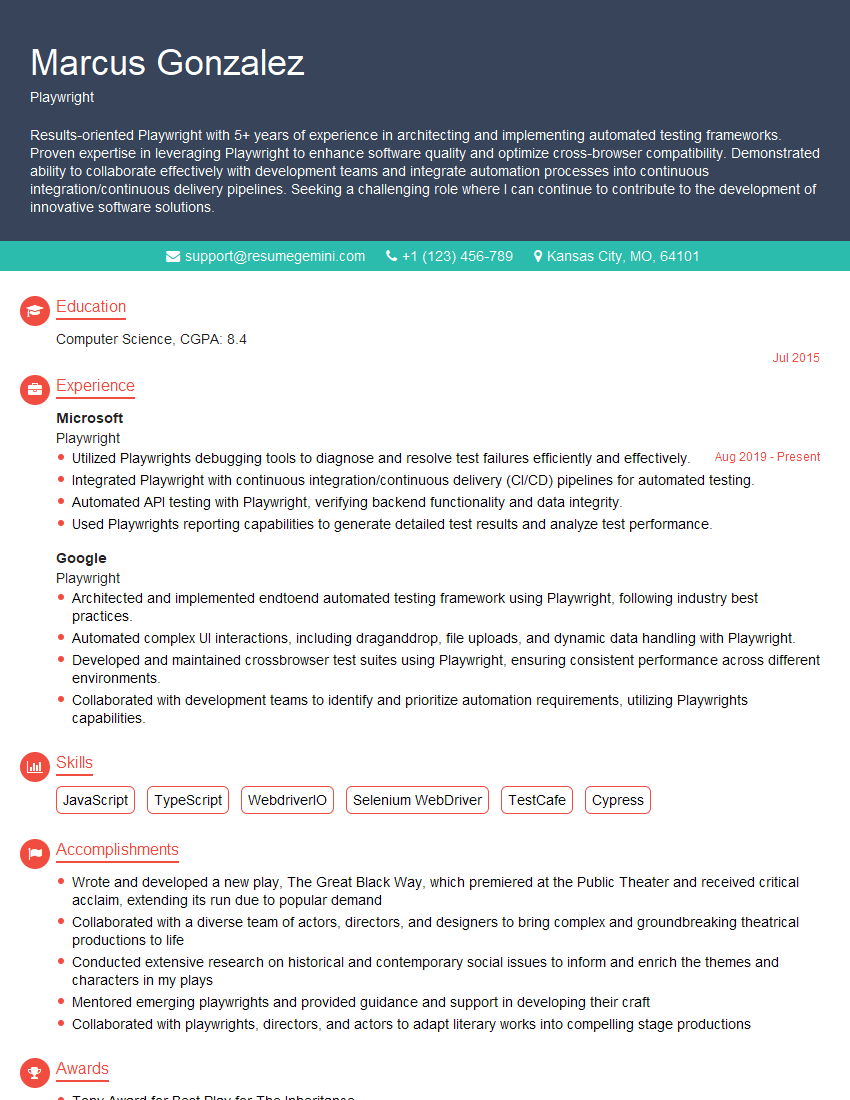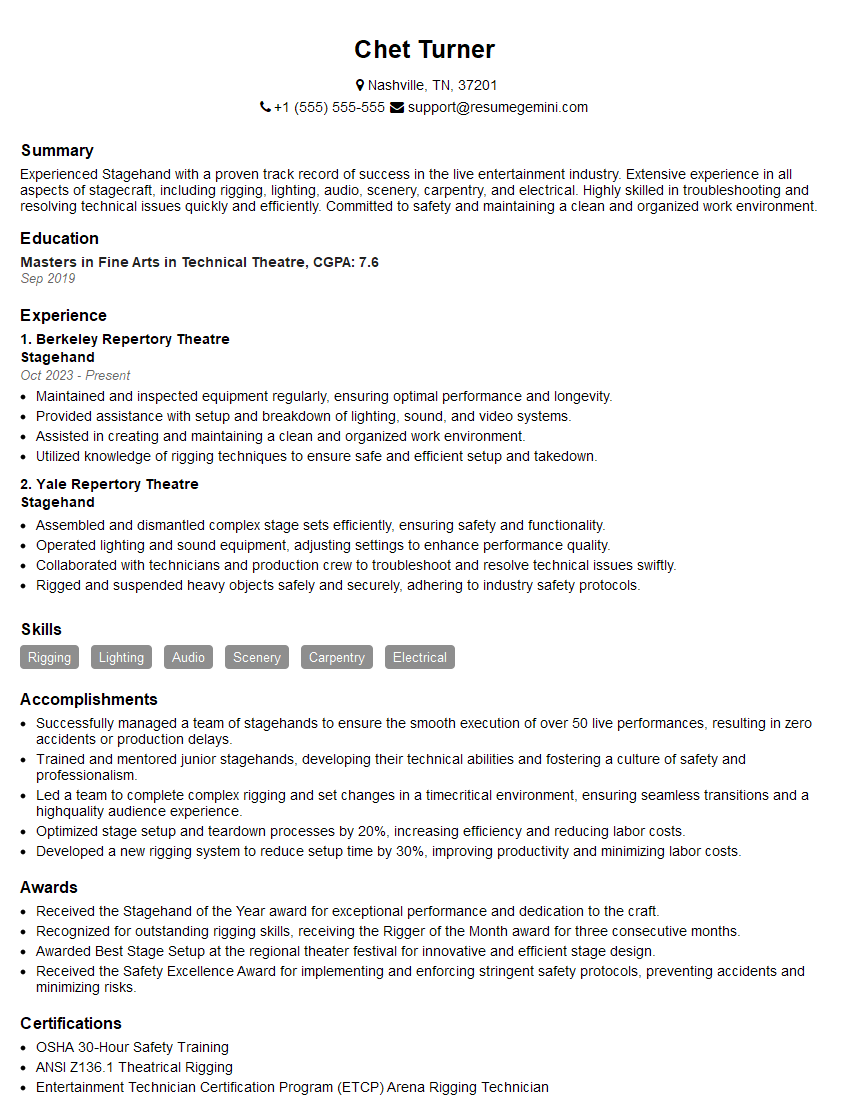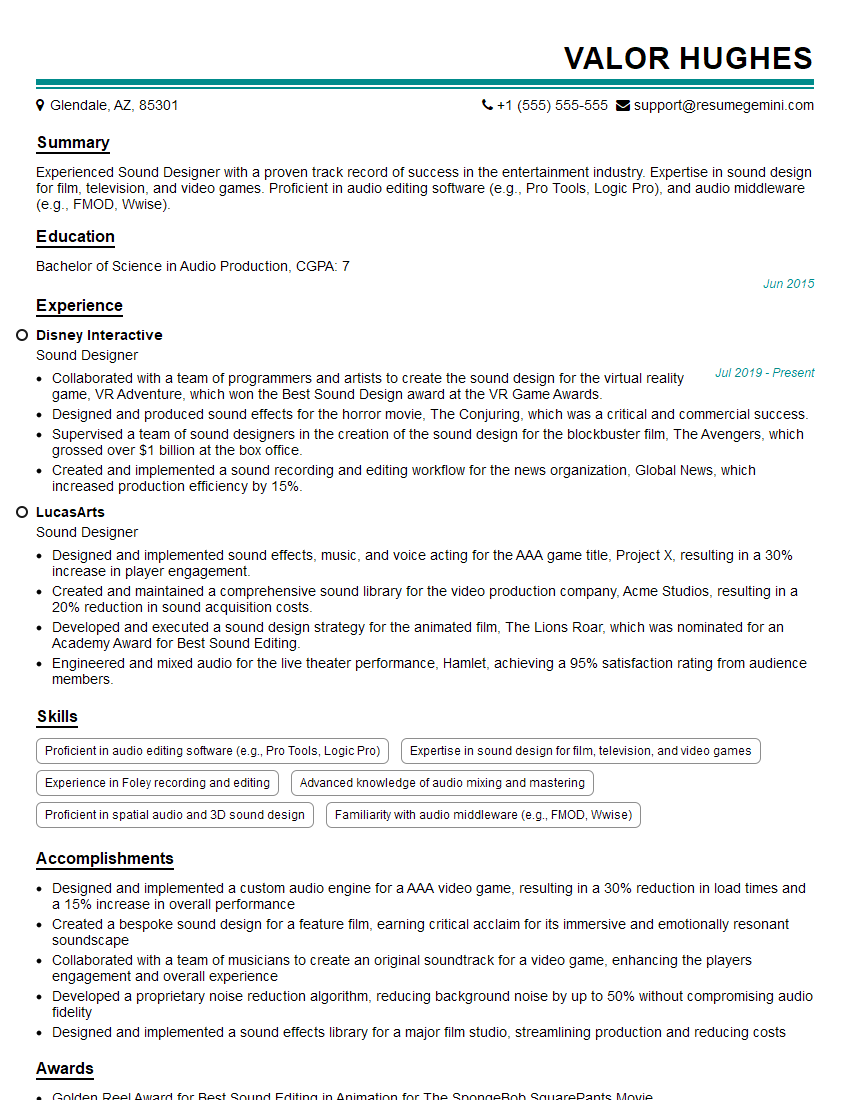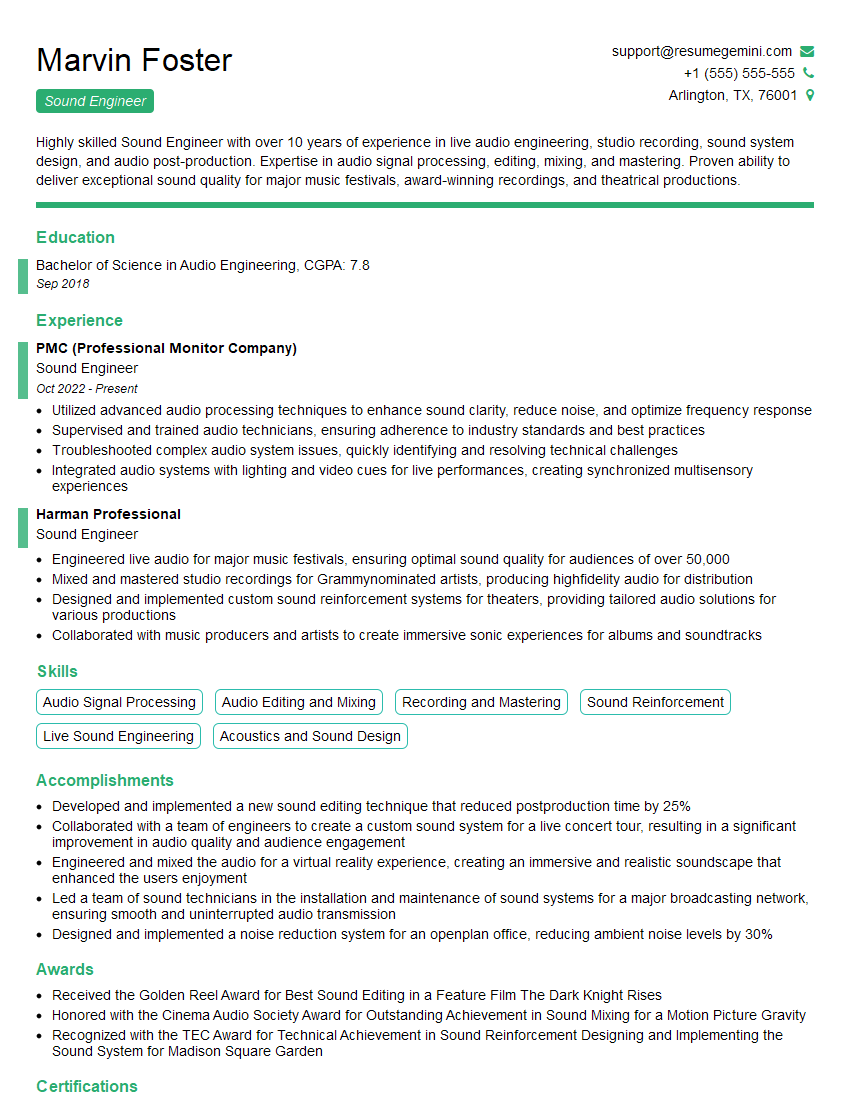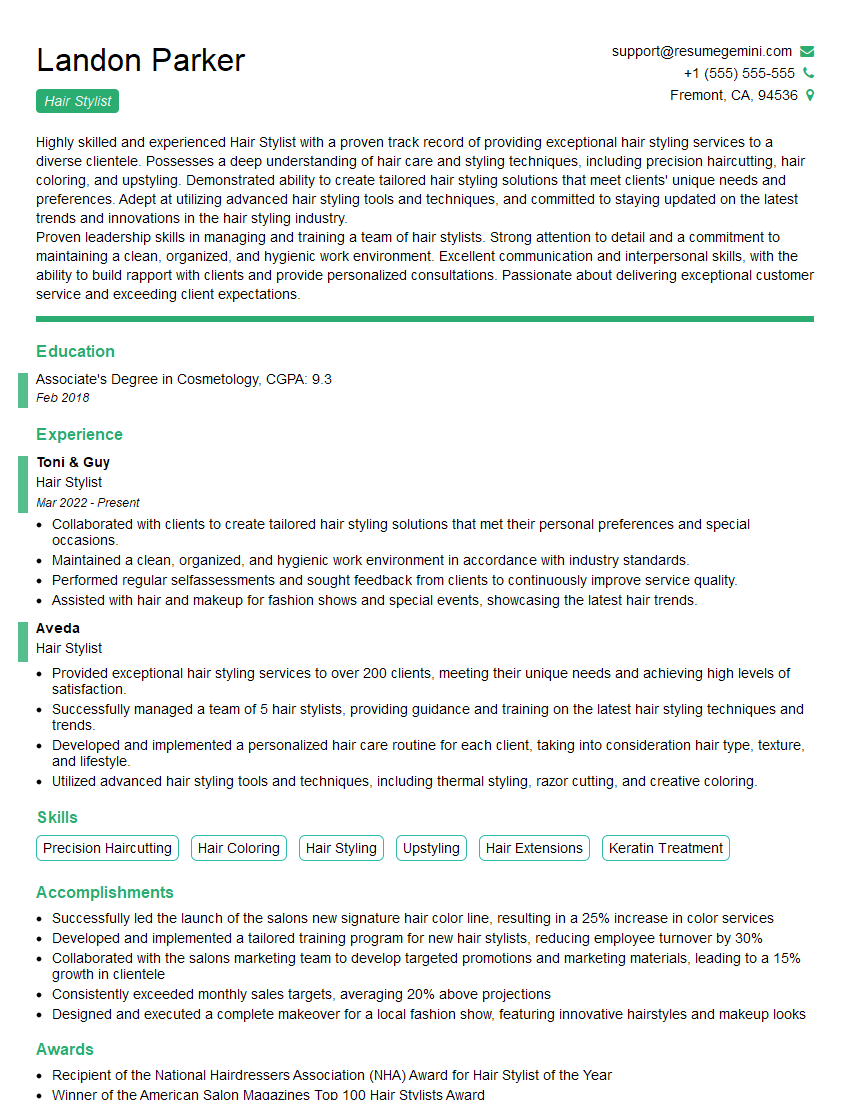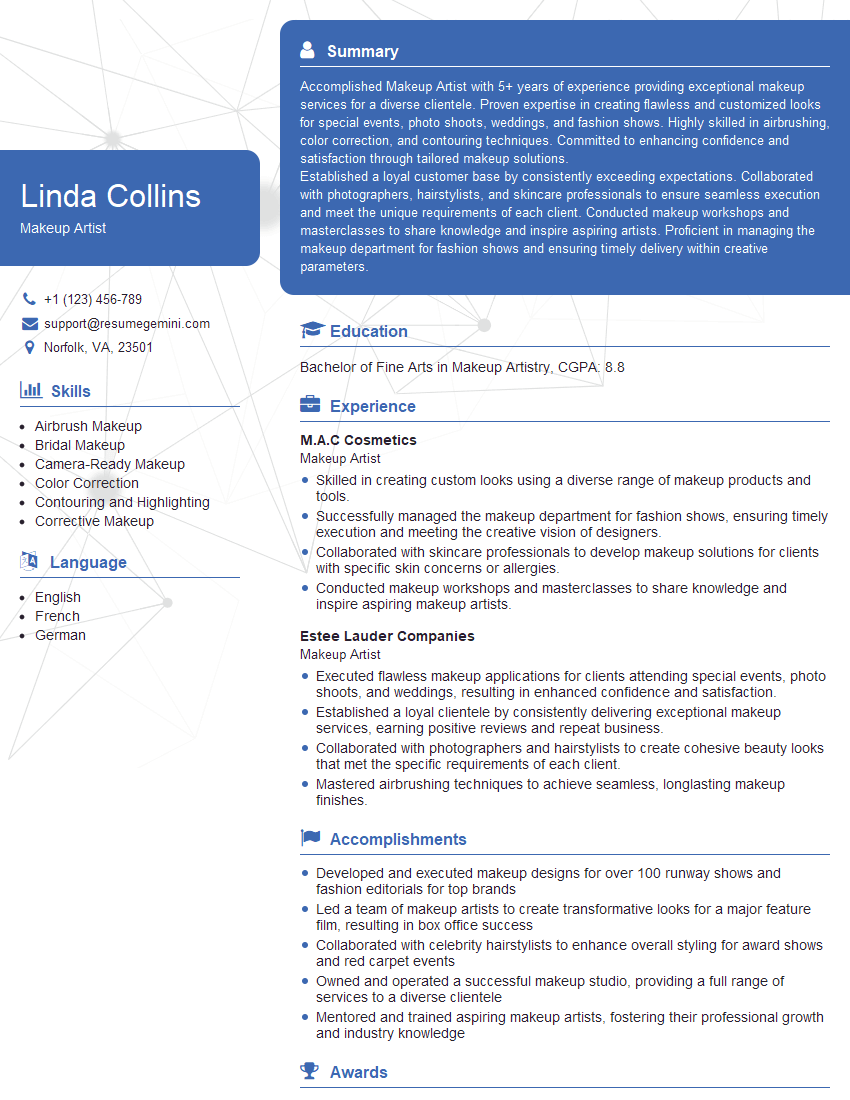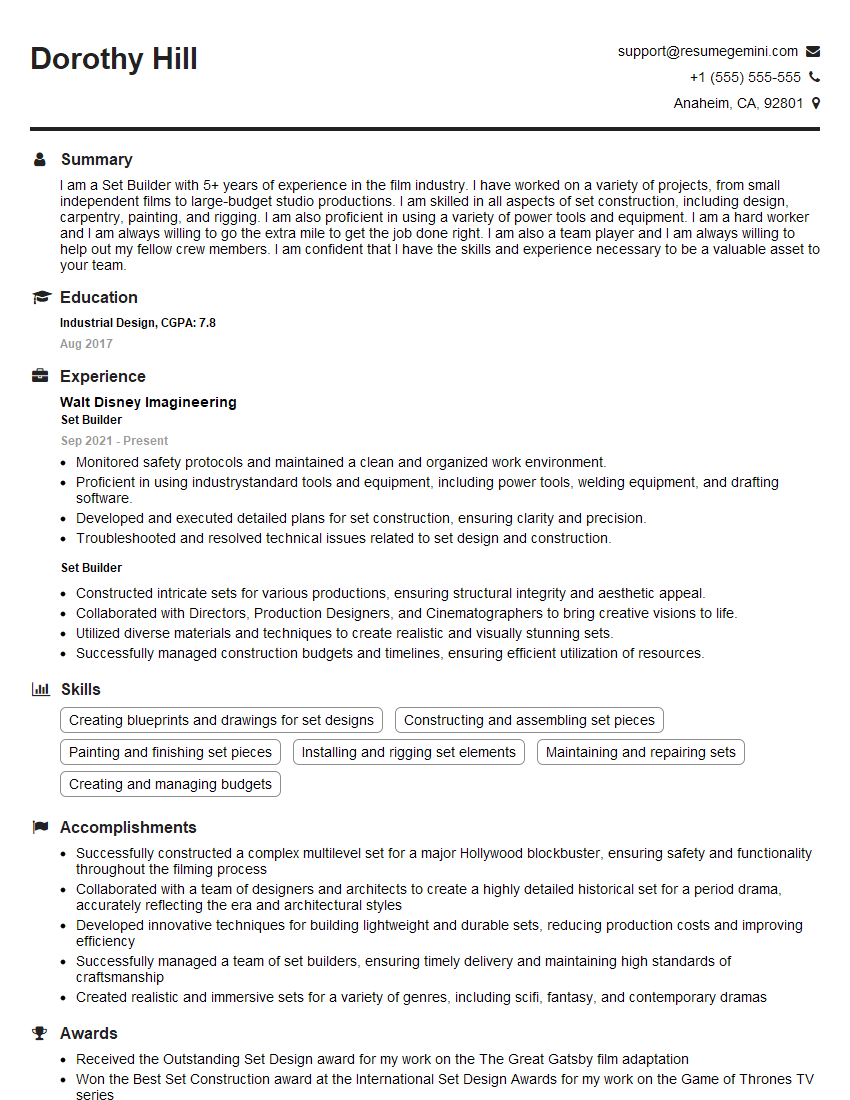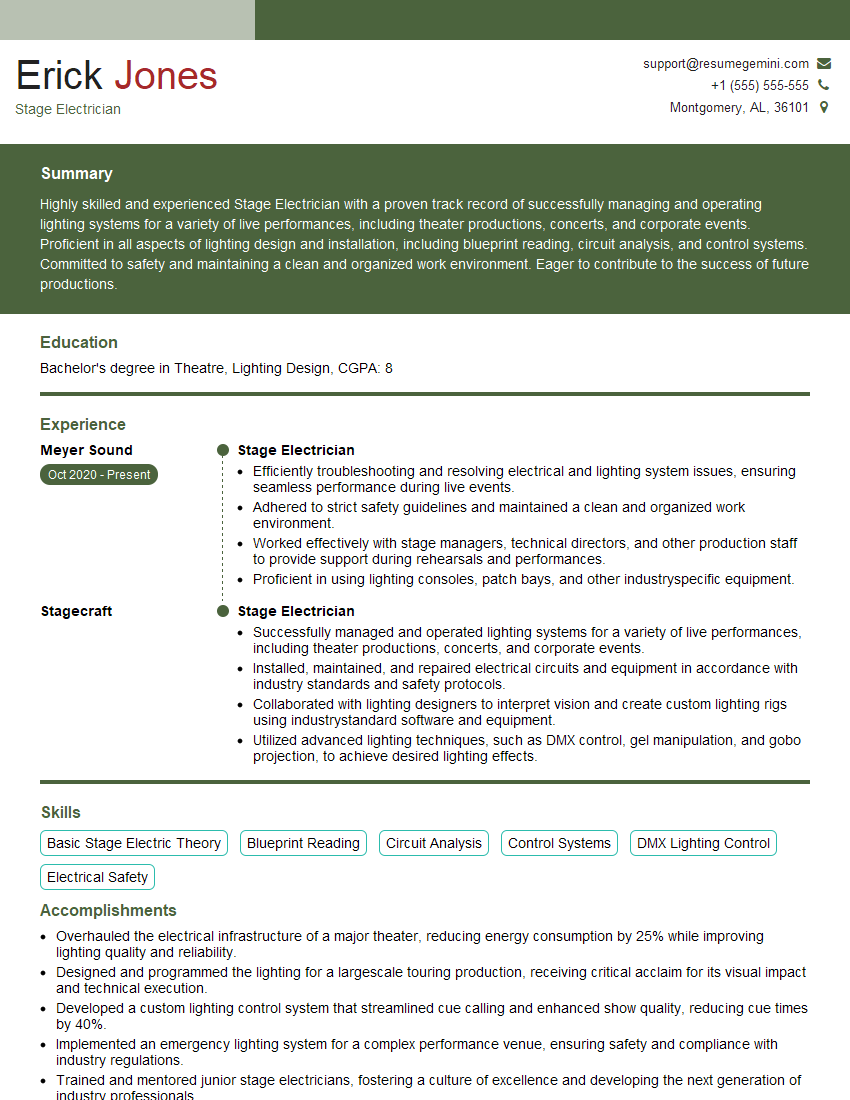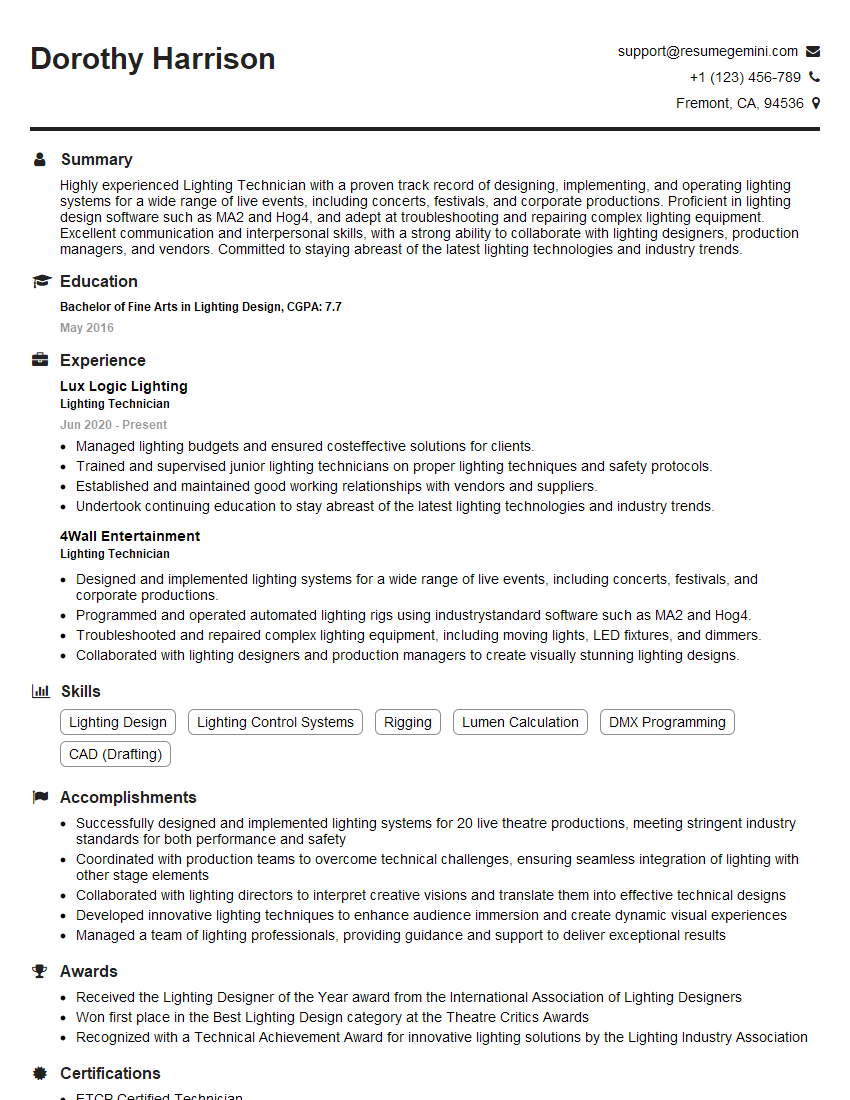Feeling uncertain about what to expect in your upcoming interview? We’ve got you covered! This blog highlights the most important Stage Performance interview questions and provides actionable advice to help you stand out as the ideal candidate. Let’s pave the way for your success.
Questions Asked in Stage Performance Interview
Q 1. Describe your experience with stage lighting techniques.
Stage lighting is a crucial element in setting the mood, focusing the audience’s attention, and enhancing the storytelling in a performance. My experience encompasses a wide range of techniques, from conventional lighting using Fresnels, ellipsoidal reflectors, and PAR cans, to the more advanced use of LED fixtures and moving lights. I’m proficient in designing lighting plots using various color temperatures, intensities, and gobo patterns to achieve specific effects. For instance, I once designed a lighting scheme for a Shakespearean play that used warm, amber tones for romantic scenes and cool blues for moments of tension. This involved carefully positioning and angling the lights to highlight key actors and create depth on stage. I also have extensive experience in using automated lighting systems to create dynamic and exciting visual sequences, including chases, crossfades, and color washes. I understand the importance of balancing aesthetics with the practical requirements of a show, ensuring safety and efficiency throughout the lighting process.
Q 2. Explain the process of sound mixing for a live performance.
Sound mixing for a live performance is a demanding yet rewarding process that requires a combination of technical skill and artistic sensitivity. It begins with pre-production planning, which involves carefully listening to the artists’ needs and recording requirements. The next crucial step is setting up the sound system, including microphones, mixers, amplifiers, and speakers. This requires careful placement of microphones to avoid feedback and ensure optimal sound capture from each instrument or voice. During the performance, I use the mixing console to adjust levels, EQ, and effects in real-time to maintain a consistent and pleasing sound. This involves balancing the different instruments and vocals, ensuring that each element is clearly audible and that there’s no muddiness or masking. I use EQ to shape the sound and adjust compression to prevent distortion. Managing the dynamics and ensuring clarity remain consistent throughout the entire show are critical aspects of my approach. It’s like being a conductor, harmonizing every sonic element to create a cohesive and impactful soundscape. I also work extensively with delay and reverb effects to add depth and ambiance to the performance, reflecting the overall tone and style of the show.
Q 3. How would you troubleshoot a malfunctioning lighting fixture during a show?
Troubleshooting a malfunctioning lighting fixture during a show requires a quick and systematic approach. First, I assess the nature of the problem. Is the light completely out, flickering, or displaying an incorrect color? Then, I check the obvious: is the fixture properly connected, is the bulb burnt out, are the circuits working correctly? If it’s a simple bulb change, that is the immediate fix. If the problem is electrical, I’d check the dimmer and power supply to see if there is a tripped breaker or a blown fuse. I always have a backup plan in place and a selection of spare bulbs available. If the issue is more complex, I’d communicate with the lighting operator immediately, and if necessary, we’d use a backup fixture or adjust the lighting plot to mitigate the impact on the show. For example, if a key spotlight goes out during a solo performance, we might use a wash light to provide general illumination while we work on resolving the issue. Communication with the stage manager is crucial here, informing them of the problem and any potential adjustments to the stage directions that might be required.
Q 4. What software are you proficient in for stage design or lighting plotting?
I’m proficient in several software packages used for stage design and lighting plotting. My primary software is Vectorworks Spotlight, which I use for creating detailed 2D and 3D models of the stage, designing lighting plots, and programming cues. I’m also experienced with other industry-standard software, such as WYSIWYG, which allows me to visualize the lighting design before the show through highly realistic simulations. This helps identify potential issues and make adjustments before the actual setup. Furthermore, I possess knowledge of ETC Eos family consoles and their programming software, essential for controlling complex lighting systems and creating dynamic cues during live performances. Familiarity with these different platforms empowers me to adapt quickly to different project needs and collaborate efficiently with other professionals.
Q 5. Detail your experience with cueing systems and their operation.
Cueing systems are fundamental for smooth and efficient stage productions. My experience involves working with a variety of cueing systems, both manual and automated. I’m comfortable with traditional methods, such as using a lighting console to manually trigger lighting cues, as well as utilizing sophisticated automated systems like ETC EOS or MA Lighting grandMA2. These systems allow for precise timing and sequencing of lighting, sound, and other stage effects. I’m adept at creating and programming cues, ensuring seamless transitions between different scenes and maintaining the artistic integrity of the director’s vision. For instance, in a recent musical production, I programmed intricate lighting cues synchronized to the music, creating a dynamic and visually captivating experience. This included using different functionalities within the console for fading, crossfading, and colour changes, all timed to the music score precisely.
Q 6. How do you manage multiple tasks simultaneously during a performance?
Managing multiple tasks simultaneously during a performance is a critical skill for stage technicians. It’s like conducting an orchestra, where every instrument needs to be balanced perfectly. I achieve this through careful planning, organization, and prioritization. Before the show, I make sure all systems are checked and ready. During the performance, I use a combination of visual cues, communication with other crew members, and a pre-planned schedule to anticipate upcoming changes. I use checklists to monitor tasks and prioritize immediate needs. For example, if a lighting cue needs to change and a sound adjustment is also needed, I will prioritize the most urgent and communicate the others to the appropriate team members to handle while I attend to the other. Effective communication and delegation are crucial for keeping the show running smoothly, and experience helps in recognizing the priorities and the right course of action quickly and effectively.
Q 7. Describe your experience collaborating with actors and directors.
Collaboration is essential in stage performance. My experience working with actors and directors has been extremely rewarding and has shaped my approach to technical work. I understand that my technical role directly supports the artistic vision, therefore effective communication is vital. I actively listen to the director’s ideas and work closely with actors to understand their needs for lighting and sound to effectively interpret their expressions and enhance their performances. For example, during rehearsals, I would work with the actors to find the best lighting positions for specific scenes, highlighting their facial expressions or body language to help bring their characters to life. Building rapport with actors and creating a collaborative environment is important for me, so they feel comfortable expressing their needs and contribute to the creative process. This fosters a supportive environment where everyone works together towards a successful and impactful performance.
Q 8. How do you handle unexpected technical issues during a production?
Handling unexpected technical issues requires a calm, methodical approach and a proactive mindset. My strategy involves a layered response: first, immediate problem identification; second, damage control; and third, solution implementation.
For example, if a spotlight malfunctions mid-scene, my immediate action is to assess the severity. Is the entire lighting cue affected, or just one element? If it’s a minor issue, I’d signal a stagehand to attempt a quick fix, while simultaneously alerting the lighting designer via headset. If it’s a major outage, I might have a backup cue ready or utilize existing lights to create a temporary solution, communicating the change to the actors subtly to maintain the flow of the performance.
Post-show, a thorough debrief with the technical crew is crucial to understand the root cause, prevent future occurrences, and document any necessary repairs or replacements. This proactive approach ensures minimal disruption to the audience experience and maintains the professionalism of the production.
Q 9. Explain your approach to creating a cohesive stage design.
Creating a cohesive stage design is a collaborative process, starting with a deep understanding of the script and director’s vision. I begin by sketching out various concepts, considering factors like set pieces, lighting, sound, and the overall atmosphere. This is followed by detailed technical drawings and models to ensure proper scaling and functionality.
Cohesion comes from a unified theme and consistent style. For example, if the play is set in a Victorian era, every element—costumes, props, set design, even lighting—should contribute to that specific aesthetic. I also emphasize the flow of movement across the stage, ensuring there are no jarring transitions or obstructions for both actors and the audience’s line of sight. Effective communication with the set designer, costume designer, lighting designer, and sound designer is crucial during this process to ensure everyone is working towards a shared visual and auditory experience. This interdisciplinary approach transforms the stage from a mere setting into a fully realized world that resonates with the narrative.
Q 10. What strategies do you use for efficient stage management?
Efficient stage management relies on meticulous planning and clear communication. I use a combination of strategies, including detailed schedules, run-throughs, and comprehensive cue sheets. Pre-production involves creating a master schedule outlining every aspect of the performance—from rehearsals to load-in and strike.
During rehearsals, I maintain a detailed log of any necessary changes or adjustments. This information feeds directly into the final cue sheet which functions as a bible for every crew member. Utilizing technology, such as digital cue sheets and communication apps, ensures everyone has access to real-time updates. Finally, a well-structured call time sheet ensures everyone arrives on time and knows their responsibilities. My approach keeps the production running smoothly and allows for flexibility in the face of unexpected events.
Q 11. How do you ensure the safety of performers and crew members?
Ensuring performer and crew safety is paramount. This begins with a thorough risk assessment of the production. I identify potential hazards, from tripping hazards on set to potential electrical risks, and develop mitigation strategies.
This includes implementing clear safety protocols, providing comprehensive safety training to all crew members, and ensuring that all equipment is regularly inspected and maintained. We use designated safety personnel to monitor the stage during performances and rehearsals, paying particular attention to any potential dangers. Proper lighting, clear walkways, and the use of appropriate safety gear are non-negotiable. We regularly conduct emergency drills to ensure everyone knows what to do in case of an accident. A strong safety culture, fostered through open communication and clear expectations, is crucial to maintaining a safe and professional work environment.
Q 12. Describe your experience with different types of stage rigging.
My experience with stage rigging encompasses various systems, including counterweight systems, motorized rigging, and manual systems. I am proficient in the safe operation and maintenance of each, understanding their limitations and the potential hazards associated with them.
Counterweight systems, for instance, require precise calculations and meticulous attention to detail to prevent accidents. Motorized systems provide automation and efficiency, but their programming and maintenance demand expertise. Manual systems, though simpler, require physical strength and careful coordination. I have worked with a variety of rigging equipment, from simple pulleys to complex flying systems. Understanding the load-bearing capacity of each component and adhering to strict safety regulations is paramount. I regularly stay updated on industry best practices and technological advancements in stage rigging to maintain my proficiency and ensure the safety of both performers and the crew.
Q 13. What are your preferred methods for communicating with the technical crew?
Clear and efficient communication with the technical crew is critical. I primarily utilize a multi-faceted approach, combining headset communication during performances with pre-show meetings and detailed cue sheets. Headsets allow for instant feedback and coordination during the show, crucial for resolving issues quickly and efficiently.
Pre-show meetings serve to clarify expectations, address potential concerns, and ensure everyone is on the same page regarding the performance’s technical aspects. Detailed cue sheets, supplemented with visual aids where necessary, provide a comprehensive guide for each crew member, minimizing misunderstandings. I also utilize a combination of hand signals and nonverbal cues during the performance for rapid adjustments, allowing for a smooth and seamless performance even with sudden changes or difficulties. Establishing a culture of open communication, where crew members feel comfortable voicing concerns, is key to a successful production.
Q 14. Explain your knowledge of different microphone types and their applications.
My knowledge of microphones spans various types, each suited for specific applications. Dynamic microphones, known for their durability and resistance to feedback, are ideal for loud stage performances, such as vocals and instruments. Condenser microphones offer greater sensitivity and detail, making them suitable for capturing subtle nuances in vocals and instruments in a controlled environment.
Lapel microphones are discreet and ideal for close miking actors, while headset microphones offer hands-free operation and are often used in theatrical productions. Boundary microphones, placed on surfaces, provide a flat response and are commonly used for conference settings. The choice of microphone depends largely on the specific acoustic environment, the desired sound quality, and the distance between the source and the microphone. Understanding the polar patterns (cardioid, omnidirectional, etc.) of different microphones is essential for effective sound reinforcement and minimizing feedback.
Q 15. How do you maintain organization and efficiency in a high-pressure environment?
Maintaining organization and efficiency in the high-pressure environment of stage performance relies on proactive planning and adaptable strategies. Think of it like conducting an orchestra – each musician needs their part, and the conductor needs to ensure seamless coordination.
- Detailed Scheduling: I utilize project management software to create detailed schedules, breaking down complex tasks into smaller, manageable steps. This allows for clear visualization of deadlines and progress tracking.
- Prioritization Matrix: A crucial tool is a prioritization matrix (like Eisenhower Matrix) that categorizes tasks by urgency and importance. This ensures that critical elements, like lighting cues or set changes, receive timely attention.
- Pre-Production Checklists: Comprehensive checklists for every stage of production – from design to tech rehearsals – act as safety nets, minimizing overlooked details and ensuring consistency.
- Regular Communication: Open and consistent communication with the team is key. Daily briefings or stand-up meetings, where we discuss progress, challenges, and solutions, contribute immensely to maintaining momentum and addressing potential roadblocks swiftly.
For example, during a recent production of ‘Hamlet’, we faced a last-minute set malfunction. Our pre-production checklist highlighted backup solutions, and our communication channels allowed us to swiftly implement the alternate design, minimizing disruption.
Career Expert Tips:
- Ace those interviews! Prepare effectively by reviewing the Top 50 Most Common Interview Questions on ResumeGemini.
- Navigate your job search with confidence! Explore a wide range of Career Tips on ResumeGemini. Learn about common challenges and recommendations to overcome them.
- Craft the perfect resume! Master the Art of Resume Writing with ResumeGemini’s guide. Showcase your unique qualifications and achievements effectively.
- Don’t miss out on holiday savings! Build your dream resume with ResumeGemini’s ATS optimized templates.
Q 16. What are your skills in conflict resolution within a team?
Conflict resolution in a team setting is paramount for a successful production. It’s about understanding diverse perspectives and finding common ground, not necessarily about winning an argument.
- Active Listening: I prioritize active listening to understand the root cause of the conflict, rather than focusing solely on the surface-level issue. This involves truly hearing what each person is saying, even if it’s difficult.
- Mediation and Facilitation: If a conflict arises, I try to mediate between parties, acting as a neutral facilitator to help them find a solution collaboratively. The goal is to create an environment where everyone feels heard and respected.
- Focus on Shared Goals: I constantly remind the team of our shared goals – delivering a quality performance. This helps refocus discussions on the bigger picture and de-escalate tensions.
- Respectful Communication: I maintain a respectful and professional demeanor at all times, even in tense situations. This sets the tone for a constructive dialogue.
In a past production of ‘A Midsummer Night’s Dream’, a disagreement arose between the costume designer and the lighting designer. By actively listening to their concerns, I helped them reach a compromise that enhanced both the visual and theatrical aspects of the play.
Q 17. Describe your familiarity with different stage automation systems.
My familiarity with stage automation systems extends across several platforms, including ETC EOS, MA Lighting grandMA2, and Chamsys MagicQ. Understanding these systems is crucial for seamlessly integrating technology into theatrical productions.
- ETC EOS: I am proficient in programming lighting cues, utilizing its powerful features for complex sequences and effects. I have experience with its networking capabilities, allowing for precise control across multiple consoles.
- MA Lighting grandMA2: I understand its sophisticated capabilities for large-scale productions, including its ability to manage complex moving light fixtures and media servers. I have experience creating and managing show files within this system.
- Chamsys MagicQ: I am familiar with its user-friendly interface, making it ideal for smaller productions or those with limited budgets. I have used it for both lighting and media server control.
For instance, in a recent musical, I leveraged the networking capabilities of the ETC EOS system to synchronize lighting cues with automated set pieces, creating a dynamic and immersive experience for the audience. The ability to seamlessly integrate these systems is vital for creating a cohesive and impactful theatrical experience.
Q 18. How do you prioritize tasks during a hectic production schedule?
Prioritizing tasks during a hectic production schedule requires a strategic approach. It’s similar to a firefighter – you need to address the most immediate threats first, but keep the overall picture in mind.
- Dependency Mapping: I create a visual representation of tasks, highlighting their interdependencies. This helps identify critical path tasks – those that must be completed before others can begin.
- Timeboxing: I allocate specific time blocks for each task, encouraging focus and preventing task-switching, which reduces efficiency.
- Agile Methodology: I employ agile principles by breaking down large tasks into smaller, iterative steps. This allows for flexibility and adaptation to unforeseen challenges.
- Regular Review and Adjustment: Consistent review of the schedule allows for adjustments based on progress and unexpected hurdles. This ensures the production remains on track.
During a particularly challenging production of ‘Chicago’, we faced unexpected delays with set construction. By using the dependency mapping and agile methodologies, I was able to prioritize tasks effectively, ensuring we remained on schedule for the opening night.
Q 19. What is your experience with creating and managing a show budget?
Creating and managing a show budget involves meticulous planning and rigorous tracking. Think of it as carefully allocating resources to maximize impact.
- Detailed Budgeting: I create a comprehensive budget that outlines every expense, from set design and costumes to marketing and technical fees.
- Cost Tracking: I utilize spreadsheet software to track expenses diligently, ensuring that spending remains within budget constraints.
- Negotiation and Procurement: I have experience negotiating with vendors to secure the best prices for materials and services, helping to minimize costs.
- Contingency Planning: I always incorporate a contingency fund to handle unforeseen expenses, ensuring the production’s financial stability.
In a recent production of ‘Les Misérables’, I developed a budget that secured cost-effective solutions while maintaining high production quality. Successful budget management involves not only cost-cutting but also strategic allocation of resources to areas that maximize impact.
Q 20. How do you adapt to different performance spaces and their technical capabilities?
Adapting to different performance spaces demands flexibility and adaptability. It’s like adapting a recipe to the ingredients you have on hand.
- Site Survey: I always conduct a thorough site survey to assess the venue’s technical capabilities, including lighting grids, sound systems, and stage dimensions.
- Technical Rider: I work closely with the venue’s technical team, creating a detailed technical rider that outlines the production’s specific requirements.
- Design Adaptation: I am adept at adapting the design elements – sets, lighting, and sound – to accommodate the unique constraints of each venue.
- Problem-Solving: I proactively address potential challenges arising from the venue’s limitations, such as limited space or unusual stage dimensions.
During a tour of ‘The Sound of Music’, we performed in venues ranging from intimate theaters to large auditoriums. Each venue presented unique challenges, but through careful planning and adaptability, we maintained the production’s artistic integrity.
Q 21. Explain your understanding of copyright and licensing in theatre productions.
Understanding copyright and licensing is essential for avoiding legal complications in theatre productions. It’s crucial to respect the intellectual property rights of playwrights, composers, and other artists.
- Script Licensing: I am familiar with the process of securing performance rights from agencies like Music Theatre International (MTI) or Samuel French. I understand the importance of obtaining the correct license for each performance and adhering to its terms.
- Music Licensing: I understand the necessity of obtaining licenses for any music used in the production, whether it’s original compositions or existing works. This may involve contacting the copyright holders directly or using a licensing agency like ASCAP or BMI.
- Public Domain: I am knowledgeable about public domain works, which are not subject to copyright restrictions. I know how to determine if a work is in the public domain.
- Copyright Infringement: I am aware of the potential consequences of copyright infringement, such as legal action and financial penalties. I prioritize adhering to copyright laws meticulously.
In a production of ‘Rent’, for example, securing the necessary performance and music licenses was a crucial step to ensure the legality and smooth execution of the production.
Q 22. How do you ensure accessibility for performers with disabilities?
Ensuring accessibility for performers with disabilities is paramount. It’s not just about legal compliance; it’s about creating a truly inclusive and equitable environment where every individual’s talent can shine. My approach involves a multi-faceted strategy that begins even before the casting process.
Early Consultation: I actively seek input from disability organizations and accessibility experts during the initial planning stages to ensure the venue and production are designed with accessibility in mind. This might involve considering wheelchair access, appropriate seating arrangements, accessible restrooms, and clear signage.
Adaptive Techniques: I work closely with performers with disabilities to understand their unique needs and incorporate adaptive techniques into the production. This could involve modifying choreography to accommodate physical limitations, providing assistive listening devices, or using alternative communication methods.
Assistive Technology: We explore the use of various assistive technologies, such as captioning, audio description, and sign language interpretation, to make the performance accessible to a broader audience. For example, we might use real-time captioning projected onto a screen for deaf or hard-of-hearing audience members.
Inclusive Casting: The casting process is designed to be inclusive, actively seeking out and welcoming applications from performers with disabilities. This ensures that diverse voices and perspectives are represented on stage.
Training and Education: The entire production team, including actors, stagehands, and technicians, receives sensitivity training to foster a supportive and understanding environment. This training covers various disabilities and how to best support performers with those specific needs.
For instance, in a recent production, we worked with a visually impaired actor who integrated braille scripts and directional audio cues into his performance to successfully portray his character.
Q 23. Describe your approach to creating a safe and inclusive working environment.
Creating a safe and inclusive working environment is fundamental to successful stage production. It’s about fostering a culture of respect, collaboration, and mutual support, built on clear communication and established protocols.
Clear Communication Channels: I establish open and accessible communication channels where everyone feels comfortable voicing concerns or feedback. This includes regular team meetings, anonymous suggestion boxes, and readily available contact information for myself and other key personnel.
Zero Tolerance Policy: A strict zero-tolerance policy towards harassment, discrimination, and bullying is implemented and consistently enforced. Everyone on the team understands the consequences of violating this policy.
Respectful Workplace Guidelines: Detailed guidelines regarding respectful behavior, workplace etiquette, and conflict resolution are distributed and discussed with the entire team. These guidelines are adapted to the specific needs of the production and team involved.
Safety Training and Protocols: Comprehensive safety training is provided to all team members, covering topics such as fire safety, emergency procedures, safe handling of equipment, and hazard awareness. Detailed safety protocols are developed and strictly followed.
Mental Wellbeing Support: Recognizing the demanding nature of stage production, I prioritize mental health and wellbeing. We provide access to resources such as Employee Assistance Programs or mental health professionals, ensuring team members have the support they need.
For example, I’ve implemented a system of daily ‘check-ins’ during demanding rehearsal periods, allowing individuals to share concerns anonymously, ensuring early identification and support of anyone experiencing stress or burnout.
Q 24. What is your experience with integrating new technology into a stage production?
Integrating new technology into stage productions is an exciting aspect of my work, requiring both technical proficiency and creative vision. My experience spans several technologies, from sophisticated lighting and sound systems to augmented reality and virtual reality elements.
Lighting and Sound: I have extensive experience using advanced lighting consoles, such as the ETC EOS family, and sound mixing boards, like those from Yamaha. I understand how to program complex lighting cues, utilize spatial audio techniques, and integrate these technologies seamlessly into a cohesive production design.
Video Integration: I’m adept at integrating video projections, LED screens, and other display technologies to enhance storytelling and create visually stunning effects. I work closely with video designers and technicians to ensure the video elements sync perfectly with the rest of the production.
Augmented and Virtual Reality: I’ve explored the application of AR and VR in stage productions, using these technologies to create immersive and interactive experiences for audiences. This includes projection mapping onto physical sets and creating virtual environments to transport the audience to different worlds.
Data Analysis and Optimization: Modern technology also provides opportunities for data-driven decision making. Using audience analytics and performance data, I can optimize various elements of the production to maximize impact and engage viewers more effectively.
For instance, in a recent project, we incorporated interactive augmented reality elements into a historical play, allowing audience members to view historical documents and artifacts superimposed on the stage setting through their smartphones. This technology greatly enhanced the learning and audience engagement aspects of the show.
Q 25. How do you manage time constraints and deadlines effectively?
Effective time management and meeting deadlines in stage production require meticulous planning, clear communication, and a proactive approach to problem-solving. My strategy is built upon several key principles.
Detailed Scheduling: I create a comprehensive production schedule that encompasses all aspects of the production, from pre-production planning and rehearsals to technical rehearsals and the final performances. This schedule is regularly reviewed and updated to accommodate any changes or delays.
Prioritization and Delegation: I prioritize tasks based on their urgency and importance, effectively delegating tasks to the appropriate team members. This ensures that everyone is working efficiently and productively towards the common goal.
Regular Check-ins and Progress Reports: Regular check-in meetings and progress reports are used to monitor the progress of all tasks, addressing potential issues proactively and preventing them from escalating.
Contingency Planning: I always include contingency plans in the schedule to address potential delays or unforeseen circumstances. This might involve setting aside buffer time for various tasks, identifying alternate solutions, or having backup resources readily available.
Effective Communication: Open and honest communication is crucial in managing time constraints. I ensure that all team members are fully informed about schedules, deadlines, and any potential issues that may arise.
For example, using a Gantt chart, I can visualize the various stages of production, their dependencies, and timelines, making it easier to identify potential bottlenecks and adjust schedules proactively.
Q 26. Describe your experience with pre-production planning and rehearsals.
Pre-production planning and rehearsals are the bedrock of a successful stage production. They form the framework for every aspect of the show, from creative vision to technical execution. My approach is both methodical and collaborative.
Concept Development: This stage involves in-depth discussions with the director, designers, and other key personnel to define the overall vision and aesthetic of the production. This often includes brainstorming sessions, storyboarding, and creating mood boards to establish a shared understanding of the artistic goals.
Script Analysis: A thorough analysis of the script is crucial to understand its nuances, identify potential challenges, and develop strategies to address them. This includes identifying key scenes, character arcs, and potential staging challenges.
Design and Technical Planning: Working alongside the set, costume, lighting, and sound designers, I develop detailed design plans and technical specifications that integrate seamlessly to create a visually and aurally stunning performance.
Casting and Rehearsal Schedule: A well-structured casting process is followed, followed by a detailed rehearsal schedule that gradually builds from table reads and blocking rehearsals to full technical rehearsals. This is carefully crafted to allow sufficient time for the actors to develop their characters and for the technical team to integrate their elements.
Rehearsal Process: Rehearsals are structured to progressively refine the performance, address any issues, and incorporate feedback from all stakeholders. This iterative process culminates in a series of technical rehearsals, integrating all the technical aspects of the production.
For example, during pre-production for a recent musical, we created detailed 3D models of the set and used them to help actors visualize their movements and staging. This allowed us to identify potential issues and make adjustments before moving into full-scale rehearsals.
Q 27. How do you handle feedback and criticism constructively?
Handling feedback and criticism constructively is essential for continuous improvement in stage production. It’s not just about accepting criticism; it’s about learning from it and using it to refine the production.
Active Listening: I encourage open and honest feedback from all sources, actively listening to understand the perspectives of directors, actors, designers, technical staff, and most importantly, the audience. I ensure that the feedback channels are open and easily accessible.
Seeking Clarification: When receiving feedback, I seek clarification to fully understand the concerns or suggestions raised. I don’t hesitate to ask questions to ensure that I comprehend the critique and its context.
Analytical Approach: I take an analytical approach to examining feedback, identifying patterns, and discerning constructive criticism from subjective opinions. This helps in determining which aspects of the production require attention and how to best approach those issues.
Implementation and Iteration: I prioritize the implementation of constructive feedback, making adjustments to the production based on its validity and practicality. This often involves an iterative process of adjustments and further feedback cycles.
Open Communication: I maintain open and transparent communication with the team regarding the feedback received and the subsequent changes made. This process involves sharing progress, explaining rationales, and ensuring that everyone is aware of the overall direction.
For instance, after a preview performance, we received feedback that a particular scene was confusing. By analyzing audience notes and incorporating directorial suggestions, we restructured the scene and added visual cues, significantly improving audience comprehension in subsequent performances.
Q 28. Explain your understanding of health and safety regulations in a theatre setting.
Understanding and adhering to health and safety regulations in a theatre setting is not just a legal requirement; it’s a moral imperative. The well-being of the performers, crew, and audience is paramount.
Risk Assessments: Prior to any production, a thorough risk assessment is conducted to identify potential hazards, such as fire risks, electrical hazards, tripping hazards, and potential injuries from equipment. Control measures are implemented to mitigate these risks.
Emergency Procedures: Clear emergency procedures are established and communicated to all team members, covering aspects such as fire evacuation, first aid, and incident reporting. Regular fire drills and emergency training are conducted to ensure preparedness.
Equipment Safety: All equipment is regularly inspected and maintained to ensure its safe operation. Appropriate safety precautions are implemented, including the use of personal protective equipment (PPE) where necessary.
Working at Heights: If working at heights is involved, strict protocols are followed, including the use of appropriate harnesses and fall protection equipment. Proper training is provided to ensure safe working practices.
Manual Handling: Safe manual handling techniques are emphasized, especially when moving heavy equipment or sets. Appropriate lifting equipment and techniques are utilized to prevent injuries.
Compliance with Regulations: All aspects of the production must adhere to relevant health and safety regulations, including those outlined by the relevant governing bodies (e.g., OSHA in the US, HSE in the UK). Documentation of safety procedures and risk assessments is meticulously maintained.
For example, we always ensure that proper load-bearing calculations are done for all stage elements, and that our crew is properly trained in the safe use of lifting equipment to minimize the risk of injury during setup and strike.
Key Topics to Learn for Stage Performance Interview
- Character Development: Understanding methods for creating believable and compelling characters, including physicality, vocal techniques, and emotional depth. Practical application: Discuss your approach to analyzing a script and building a character from the page to the stage.
- Acting Techniques: Familiarity with various acting styles (e.g., Meisner, Stanislavski) and their practical application in diverse performance contexts. Practical application: Explain how a specific technique helped you overcome a challenge in a past performance.
- Vocal Projection and Control: Mastering vocal techniques for clear articulation, projection, and emotional resonance, adapting to different venue sizes and audience dynamics. Practical application: Describe your experience with vocal training and how it improved your stage presence.
- Movement and Physicality: Developing stage presence, body language, and movement skills to enhance storytelling and character portrayal. Practical application: Explain how you use movement to communicate emotions or advance the narrative.
- Improvisation and Collaboration: Understanding improvisational techniques and the importance of collaboration with directors, designers, and fellow actors. Practical application: Share an example of how you successfully collaborated with others on a project.
- Audition Techniques: Mastering audition preparation, including monologue selection, cold reading, and showcasing your versatility. Practical application: Discuss your strategy for preparing for and performing at auditions.
- Script Analysis: Demonstrating the ability to critically analyze scripts, understand character motivations, and identify key dramatic elements. Practical application: Explain your process for breaking down a complex scene or character.
Next Steps
Mastering stage performance opens doors to exciting and fulfilling careers in theatre, film, television, and beyond. To maximize your job prospects, a strong, ATS-friendly resume is crucial. ResumeGemini is a trusted resource to help you craft a compelling resume that showcases your skills and experience effectively. ResumeGemini provides examples of resumes tailored to Stage Performance, ensuring your application stands out from the competition. Take the next step towards your dream career – build a powerful resume with ResumeGemini today.
Explore more articles
Users Rating of Our Blogs
Share Your Experience
We value your feedback! Please rate our content and share your thoughts (optional).
What Readers Say About Our Blog
Hi, I’m Jay, we have a few potential clients that are interested in your services, thought you might be a good fit. I’d love to talk about the details, when do you have time to talk?
Best,
Jay
Founder | CEO

